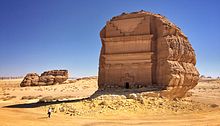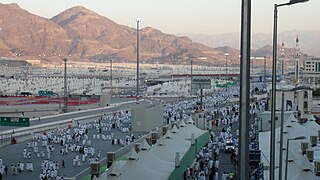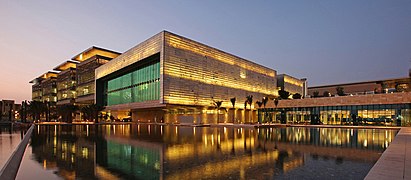Hejaz
Hejaz
Al-Ḥijāz (ٱلْحِجَاز) Hijaz | |
|---|---|
Region | |
Tabuk |
The Hejaz (
As the location of the cities of Mecca[4] and Medina,[5][6][7] respectively the first and second holiest sites in Islam, the Hejaz is significant in the Arabo-Islamic historical and political landscape. This region is the most populated in Saudi Arabia,[8] and Arabic is the predominant language, as in the rest of Saudi Arabia, with Hejazi Arabic being the most widely spoken dialect here. Some Hejazis are of ethnically diverse origins,[3] although the vast majority are of Arab origin.[9]
According to Islamic tradition, this region is the birthplace of the Islamic prophet Muhammad, who was born in Mecca, which is locally considered to have been founded by his ancestors Abraham, Ishmael, and Hagar.[10][11] The area became part of his empire through the early Muslim conquests, and it formed part of successive caliphates, first the Rashidun Caliphate, followed by the Umayyad Caliphate, and finally the Abbasid Caliphate. The Ottoman Empire held partial control over the area; after its dissolution, an independent Kingdom of Hejaz existed briefly in 1925 before being conquered by the neighbouring Sultanate of Nejd, creating the Kingdom of Hejaz and Nejd.[12] In September 1932, the Kingdom of Hejaz and Nejd joined the Saudi dominions of Al-Hasa and Qatif, creating the unified Kingdom of Saudi Arabia.[13][14]
Etymology
The name of the region is derived from a verb ḥajaza (حَجَز), from the Arabic root ḥ-j-z (ح-ج-ز), meaning "to separate",[15] and it is so called as it separates the land of the Najd in the east from the land of Tihāmah in the west.
History
Prehistoric and ancient times
One or possibly two megalithic dolmen have been found in Hejaz.[16]
The Hejaz includes both the
According to Al-Masudi the northern part of Hejaz was a dependency of ancient Israel ,[18] and according to Butrus al-Bustani the Jews in Hejaz established a sovereign state.[19] The German orientalist Ferdinand Wüstenfeld believed that the Jews established a state in northern Hejaz.[20]
The
Era of Abraham and Ishmael
According to Arab and Islamic sources, the civilization of Mecca started after
For example, in Arab or Islamic belief, the tribe of
Era of Saleh

Saudi Arabia's and Hejaz's first
Era of Muhammad
As the land of Mecca
Subsequent history

Due to the presence of the two holy cities in the Hejaz, the region was ruled by numerous empires. The Hejaz was at the center of the Rashidun Caliphate, in particular whilst its capital was Medina from 632 to 656 ACE. The region was then under the control of regional powers, such as Egypt and the Ottoman Empire, throughout much of its later history. After the Ottomans lost control of it, Hejaz became an independent state.
Brief independence
After the end of the Ottoman suzerainty and control in Arabia, in 1916,
In modern Saudi Arabia
On 23 September 1932, the two kingdoms of the Hejaz and Nejd were united as the Kingdom of Saudi Arabia.[53] This day is commemorated as the Saudi National Day.[54]
Culture

Religion
The cultural setting of Hejaz is greatly influenced by that of Islam, especially as it contains its 2 holiest cities, Mecca and Medina. Moreover, the Quran is considered the constitution of Saudi Arabia, and the Sharia is the main legal source. In Saudi Arabia, Islam is not just adhered politically by the government but also it has a great influence on the people's culture and everyday life.[55][56] The society is in general deeply religious, conservative, traditional, and family-oriented. Many attitudes and traditions are centuries-old, derived from Arab civilization and Islamic heritage.
Cuisine
Hejazi cuisine has mostly Arabian dishes like the rest of Saudi Arabia, Some dishes are native to the Hejaz, like
Geography

The region is located along the Red Sea Rift. It is also known for its darker, more volcanic sand. Depending on the previous definition, the Hejaz includes some of the mountains of the Sarat range, which topographically separate the Najd from Tehamah. Bdellium plants are also abundant in the Hejaz. Saudi Arabia, and in particular the Hejaz, is home to more than 2000 dormant volcanoes.[58] Lava fields in the Hejaz, known locally by their Arabic name of ḥarrāt (حَرَّات, singular: ḥarrah (حَرَّة)), form one of Earth's largest alkali basalt regions, covering some 180,000 km2 (69,000 sq mi), an area greater than the state of Missouri.[59]
Flags
-
Flag of the Rashidun Caliphate (632–661)
-
Flag of the Umayyad Caliphate (661–750)
-
Flag of the Abbasid Caliphate (750–1258)
-
Flag of the Fatimid Caliphate (909–1171)
-
Flag of the Ayyubid dynasty (1171–1254)
-
Flag of theMamluk Sultanate(1254–1517)
-
Flag of the Ottoman Empire (1517–1916)
-
Sheikdom of Upper Asir (1916-1920)
-
Provisional flag of the Kingdom of Hejaz from 1916 to 1917
-
Flag of the Kingdom of Hejaz (1917–1920)
-
Flag of the Kingdom of Hejaz and the Sharifian Caliphate (1920 to 1926)
-
Flag of the Kingdom of Hejaz and Nejd (1926 to 1932)
-
Flag of theKingdom of Saudi Arabia(1973–present)
Cities

International touristic development

As a component of Saudi Vision 2030, a touristic destination with an area of 28,000 square kilometres (11,000 square miles) is under development,[66] between the towns of Umluj (25°3′0″N 37°15′54.36″E / 25.05000°N 37.2651000°E) and Al-Wajh (26°14′11.76″N 36°28′8.04″E / 26.2366000°N 36.4689000°E), on the coast of the Red Sea. The project will involve "the development of 22 of the 90+ islands"[67] that lie along the coast to create a "fully integrated luxury mixed-use destination",[68] and will be "governed by laws on par with international standards".[69]
Demographics
The Hejaz is the most populated region in Saudi Arabia,
Gallery
-
The camp ofMasjid Al-Khayfis visible to the right.
-
Muslim pilgrims gathering at the plain of Mount Arafat
-
Mount Uhud in the area of Medina
-
King Abdullah University of Science and Technology (KAUST) campus at night
-
Al-Bahah City, located 2,155 m (7,070 ft) above sea level
Notable Hejazis
Al-Abwa'
- Musa al-Kazim ibn Jaʿfar al-Sadiq, descendant of Muhammad[73]
Mecca
Pre–6th century CE
- Barrahthe maternal grandmother of Muhammad
- Abd Manaf ibn Qusai, paternal ancestor of Muhammad[80]
- Abdul-Uzza, son of Qusai, and an ancestor of Barrah bint Abdul-Uzza
- Hashim, son of Abd Manaf, paternal great-grandfather of Muhammad, and the progenitor of Banu Hashim in the tribe of Quraysh
- Abdul-Muttalib ibn Hashim, paternal grandfather of Muhammad
- Hubbah bint Hulail ibn Hubshiyyah ibn Salul ibn Kaʿb ibn Amr al-Khuzaʿi, wife of Qusai, and an ancestor of Muhammad
- Atikah bint Murrah ibn Hilal ibn Falij ibn Dhakwan, wife of Abd Manaf, and an ancestor of Muhammad[80]
Since
- Muhammad ibn Abdullah ibn Abdul-Muttalib ibn Hashim[32][33]
- Caliph
- Adi ibn Ka'b ibn Lu'ayy, father-in-law of Muhammad, and Caliph
- Ali ibn Abi Talib,[32][33] cousin and son-in-law of Muhammad, and Caliph
- Hamzah, son of Abdul-Muttalib, and a paternal uncle of Muhammad, and other Muhajirun[5] or Makkan followers of Muhammad, including Ubaydah and Sa'd[32][33][47]
- Abu Talib, son of Abdul-Muttalib,[32][33] chief of Banu Hashim, paternal uncle of Muhammad, and the father of Ali
- Chief of Bani Hashim, and the paternal grandfather of Muhammad
- Asad ibn Abdul-Uzza ibn Qusai, and other Meccan wives of Muhammad
- Fatimah,[81] other daughters of Muhammad, and other Muhajir women
- Umm Sumayyah bint Khayyat, wife of Yasir ibn Amir ibn Malik al-Ansi, believed to be the first martyrfrom the followers of Muhammad
- ibn Murrah, wife of Abdullah, and the mother of Muhammad
Medina
Pre–6th century CE
- Salmah, daughter of Amr, wife of Hashim, and a great-grandmother of Muhammad[80]
Since
- Caliph sons of Ali and grandsons of Muhammad born in Medina[81]
- Caliph Umayyah ibn Abd Shamsibn Abd Manaf ibn Qusai, great-grandson of Umar ibn Al-Khattab
- Al-Hasan of Basra
- Zayd ibn Ali Zaynul-Abidin ibn Husayn ibn Fatimah bint Muhammad, half-brother of Muhammad al-Baqir
- Ansari women[32][33]
- Ja'far al-Sadiq ibn Muhammad al-Baqir[81]
- Malik the son of Anas ibn Malik ibn Abi Amir al-Asbahi (not Anas the companion of Muhammad)
- Ali al-Rida ibn Musa al-Kadhim ibn Ja'far al-Sadiq[81]
- Fatima bint Musa ibn Ja'far al-Maʿsumah of Qum,[82] sister of Ali al-Ridha
- Abu Ali Muhammad al-Jawad ibn Ali al-Ridha[81]
Ta'if
6th–7th centuries CE
- Abu al-'As ibn Umayyah ibn Abd Shams ibn Abd Manaf, son-in-law of Muhammad, and Caliph
- Urwah ibn Mas'ud,[28] chief of Banu Thaqif
- Nafi ibn al-Harith, physician[83]
Since
- Sultan Sulaiman, and a descendant of Muhammad[84]
See also
Explanatory notes
References
- ^ Mackey, p. 101. "The Western Province, or the Hejaz[...]"
- ^ ISBN 0-87779-546-0. Retrieved March 17, 2013.
- ^ ISBN 9780714632209.
- ^ a b Quran 48:22-29
- ^ a b c d Quran 9:25-129
- ^ a b Quran 33:09-73
- ^ a b Quran 63:1-11
- ^ a b "Mecca: Islam's cosmopolitan heart". Archived from the original on December 14, 2018. Retrieved July 8, 2014.
The Hijaz is the largest, most populated, and most culturally and religiously diverse region of Saudi Arabia, in large part because it was the traditional host area of all the pilgrims to Mecca, many of whom settled and intermarried there.
- ISBN 978-0-313-28354-3.
- ^ ISBN 978-0-946621-33-0.
- ^ ISBN 0-0606-3126-0.
- ISBN 978-1-84511-824-2(Pbk. ed.)
- Al-Rasheed, M. A History of Saudi Arabia. Cambridge, England, UK: Cambridge University Press, 2002. [verification needed]
- ^ A Brief overview of Hejaz - Hejaz history Archived August 15, 2018, at the Wayback Machine [verification needed]
- JSTOR 1784385.
- ISBN 978-9957-8543-3-1. Retrieved October 5, 2012.
- ^ Sullivan, Walter (March 30, 1993). "Science Watch; Signs of Ancient River". The New York Times. Archived from the original on September 21, 2022. Retrieved June 25, 2014.
- ^ Ibn Khaldun, "Kitāb al-ʻIbar wa-Dīwān al-Mubtadaʼ wa-l-Khabar", Dar Al-Fikr publication. Beirut. 1988. volume 2 page 342
- ^ al-Bustani, Butrus. "Daerat Al-Maaref". Dar Al-Marifa Publication. Beirut. volume 11 page 672
- ^ Wolfensohn, Israel. "Tarikh Al-Yahood Fi Belad Al-Arab". Al-Nafezah Publication. Cairo. 2006. page 68
- ^ Rothenberg, "Egyptian Chariots, Midianites from Hijaz/ Midian (Northwest Arabia) and Amalekites from the Negev in the Timna Mines: Rock drawings in the Ancient Copper Mines of the Arabah – new aspects of the region's history II," Institute for Archaeo-Metallurgical Studies, newsletter no. 23 (2003), p. 12.
- ^ a b Kesting, Piney. "Saudi Aramco World (May/June 2001): Well of Good Fortune". Archived from the original on October 23, 2014. Retrieved April 7, 2014.
- ^ "Family Tree of Muhammad". December 26, 2018.
- ^ Quran 2:127 -Yusuf Ali
- ^ Quran 3:96 -Yusuf Ali
- ^ a b Quran 22:25-37
- ^ Quran 106:1-4
- ^ ISBN 978-0-1963-6033-1.
- ISBN 0-8129-6618-X.
- ^ ISBN 978-0-7914-0331-0.
- ^ ISBN 978-0-87395-921-6.
- ^ ISBN 9960-899-55-1. Archived from the originalon August 20, 2011. Retrieved October 6, 2014.
- ^ ISBN 978-983-9154-17-7
- ^ Quran 15:80-84
- ^ ISBN 9781741791457.
- ^ "Al-Hijr Archaeological Site (Madâin Sâlih)". UNESCO. Archived from the original on November 11, 2022. Retrieved April 7, 2014.
- ^ a b Quran 7:73-79
- ^ a b Quran 11:61-69
- ^ a b Quran 26:141-158
- ^ a b Quran 54:23-31
- ^ a b Quran 89:6-13
- ^ a b Quran 91:11-15
- ^ "ICOMOS Evaluation of Al-Hijr Archaeological Site (Madâin Sâlih) World Heritage Nomination" (PDF). World Heritage Center. Archived from the original on November 15, 2021. Retrieved September 16, 2009.
- ^ "Information at nabataea.net". Archived from the original on December 16, 2017. Retrieved September 17, 2009.
- ^ Quran 3:110-128
- ^ a b Sahih al-Bukhari, 5:57:74
- ^ Witness Pioneer "Pre-Badr Missions and Invasions"
- ^ "Muhammad". Encyclopedia of Islam and the Muslim world.
- ^ Holt (1977), p. 57
- ^ Lapidus (2002), pp. 31–32
- ISBN 978-0-571-22664-1.
- ^ "History of Arabia". Encyclopædia Britannica.
- ^ "History of Saudi Arabia. ( The Saudi National Day 23, Sep )". Prince Mohammad Bin Fahd University. Archived from the original on December 6, 2018. Retrieved September 21, 2018.
- ^ "Saudi Arabia – Religion". Encyclopædia Britannica. Archived from the original on May 3, 2015. Retrieved February 5, 2019.
- ^ "Islam | The Embassy of The Kingdom of Saudi Arabia". www.saudiembassy.net. Archived from the original on March 30, 2018. Retrieved February 5, 2019.
- ^ "Saleeg — a Saudi dish that won't let you down". Arab News. September 11, 2013. Archived from the original on September 22, 2022. Retrieved June 23, 2021.
- ^ "The Tourists Guide To The 10 Amazing Volcanoes in Saudi Arabia". insidesaudi.com. Archived from the original on April 14, 2021. Retrieved January 9, 2021.
- ^ "VOLCANIC ARABIA: It started with tremors". archive.aramcoworld.com. Archived from the original on February 11, 2021. Retrieved January 9, 2021.
- ^ "Al-Baha City Profile". The Saudi Network. Archived from the original on September 20, 2022. Retrieved October 2, 2012.
- ^ بـتـصـرف عـن مـجـلـة الأمـانـة الـعـدد عـشـرون شـوال 1419 تـصـدر عـن أمـانـة الـمـديـنـة الـمـنـورة إمـارة مـنـطـقـة الـمـديـنـة الـمـنـورة
- ^ "Brief about Ta'if City". Ta'if City (in Arabic). Taif Municipality. Archived from the original on September 25, 2018. Retrieved April 26, 2016.
- ^ "Rābigh". GeoNames. Archived from the original on August 3, 2022. Retrieved November 28, 2017.
- ^ "Al-Juhfah | Hajj & Umrah Planner". hajjumrahplanner.com. Archived from the original on September 21, 2022. Retrieved April 10, 2017.
- ^ "Tabouk City Profile, Saudi Arabia". The Saudi Network. Archived from the original on April 19, 2017. Retrieved May 4, 2017.
- ^ "Construction underway on Saudi Red Sea project site". Zawya. February 27, 2019. Archived from the original on January 21, 2022. Retrieved March 31, 2019.
- ^ "Red Sea project master plan wins approval". The Saudi Gazette. September 17, 2017. Archived from the original on September 22, 2022. Retrieved March 31, 2019.
- ^ "Hospitality is 'anchor' of Red Sea project". Arab News. January 27, 2019. Archived from the original on September 22, 2022. Retrieved March 31, 2019.
- ^ "Saudi Arabia to allow women in bikinis at new beach resort". The USA Today. August 4, 2017. Archived from the original on August 9, 2017. Retrieved August 14, 2017.
- ^ "Saudi Arabia Population Statistics 2011 (Arabic)" (PDF). p. 11. Archived from the original (PDF) on November 15, 2013.
- ^ Riedel, Bruce (2011). "Brezhnev in the Hejaz" (PDF). The National Interest. 115. Archived from the original (PDF) on November 15, 2013. Retrieved April 23, 2012.
- ^ Beranek, Ondrej (January 2009). "Divided We Survive: A Landscape of Fragmentation in Saudi Arabia" (PDF). Middle East Brief. 33: 1–7. Archived (PDF) from the original on August 10, 2019. Retrieved June 29, 2019.
- ^ "The Infallibles Taken from Kitab al Irshad By Sheikh al Mufid". al-islam.org. Archived from the original on October 4, 2013. Retrieved November 20, 2008.
- ^ Maqsood, Ruqaiyyah Waris. "The Prophet's Line Family No 3 – Qusayy, Hubbah, and Banu Nadr to Quraysh". Ruqaiyyah Waris Maqsood Dawah. Archived from the original on May 30, 2008. Retrieved July 1, 2013.
- ^ Book of Genesis, Chapters 10, 11, 16, 17, 21 and 25
- 1 Chronicles, Chapter 1
- ^ a b Ibn Hisham. The Life of the Prophet Muhammad. Vol. 1. p. 181.
- ^ "SUNY Press :: History of al-Tabari Vol. 39, The". Archived from the original on September 12, 2006.
- ^ "Adab of Islam". Masud. Archived from the original on August 5, 2018. Retrieved August 8, 2017.
- ^ a b c Maqsood, Ruqaiyyah Waris. "The Prophet's Family Line No. 4 – Amr (Hashim), the Founder of the Hashimites". Ruqaiyyah Waris Maqsood Dawah. Archived from the original on May 30, 2008. Retrieved August 3, 2011.
- ^ ISBN 978-0-87395-510-2.
- ^ Jaffer, Masuma (2003). Lady Fatima Masuma (a) of Qom. Qum, Iran: Jami'at al-Zahra: Islamic Seminary for Women. Archived from the original on October 15, 2013. Retrieved June 5, 2018.
- ISBN 81-87570-19-9
- ^ "Pusat Sejarah Brunei" (in Malay). www.history-centre.gov.bn. Archived from the original on April 15, 2015. Retrieved August 23, 2016.
Further reading
- Mackey, Sandra (2002). The Saudis: Inside the Desert Kingdom (Updated ed.). New York: W. W. Norton and Company. ISBN 0-393-32417-6. PBK, first edition: 1987.
External links
- . Encyclopædia Britannica (11th ed.). 1911.



















